Freyssinet offer an end-to-end range of bearings designed to meet the working constraints of each structure
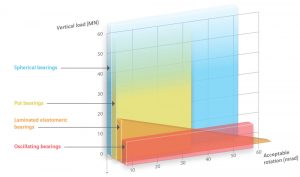
Bearings connect a structure to its support and by deformation, should allow for the following:
- Transmission of normal forces
- Horizontal movements
- Rotation of the structure in any direction
- Transmission of horizontal forces (limited by design)
The bearing may also be of a model designed and provided with a sliding device/plane that will allow it to cater for large movements in the structure in which it is installed. These horizontal movements may also be locked in one or two axes.
The company markets four distinct types of bearings.
A. Elastomeric Bearings
These are laminated bearings, made as an elastomeric rubber block reinforced with steel plates vulcanised into them when it is built. They are mainly used in the structures field for which these products have the advantage of long service life, reliability, freedom from maintenance, light weight and small dimensions as well as ease of installation.

The same qualities also make them sought after in buildings where they may be applied in vibration filtration (noise reduction) or for seismic isolation (acceleration reduction in earthquakes).
PT Freyssinet Total Technology makes and market natural rubber based bearings to meet different national or international standards (BS, AASHTO, etc) and welcomes enquiries on specific designs of such bearings.
We also make/market other elastomeric bearing products such as plain rubber bearing pads and strips and rubber dowel caps.
B. Tetron CD Pot Bearings
These bearings developed by Freyssinet since 1960, are composed of an elastomer disc confined in a cylindrical space, limited by hollow base (the pot) and a piston. The elastomer, behaving like an incompressible liquid, can transmit very high loads and absorbs structural rotations. They are made multi-directional when provided with a sliding plate and uni-directional when provided with a guide.
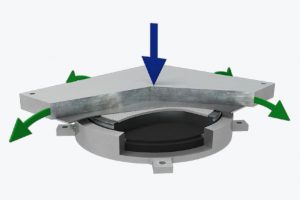
Their advantages are;
- Resistance to vertical loads, ranging from low to very high loads.
- Transmission of high vertical and horizontal forces within small overall dimensions.
- Capacity for high movement ranges in one or two horizontal directions with very low frictional coefficients and without elastic return force.
- High rotational ranges along any horizontal axis with a low resisting moment.
- Very high resistance to dynamic loads.
C. Spherical Bearings
Spherical bearings can withstand both large vertical loads and significant rotation (up to 50 mrad). They do not contain any elastomeric components, and rotation takes place on a spherical face, by contact between a sliding material and a chrome steel surface.

D. Special Bearings
Special bearings do not contain any elastomeric components. All of the functions are provided by steel/steel contact or sliding surfaces. There are several types of special bearing.
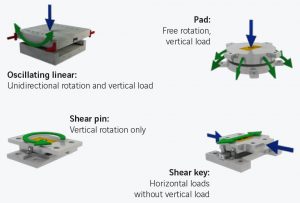
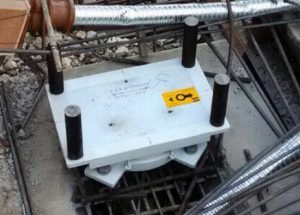 Tetron CD – Pot Bearing installation for Jembatan 4 Kotabaru Parahyangan Project
Tetron CD – Pot Bearing installation for Jembatan 4 Kotabaru Parahyangan Project
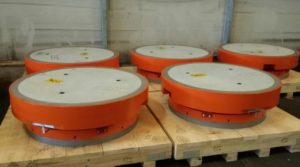
Special Bearing for Floating Production Unit (FPU) Jangkrik Complex Project
Project Reference
